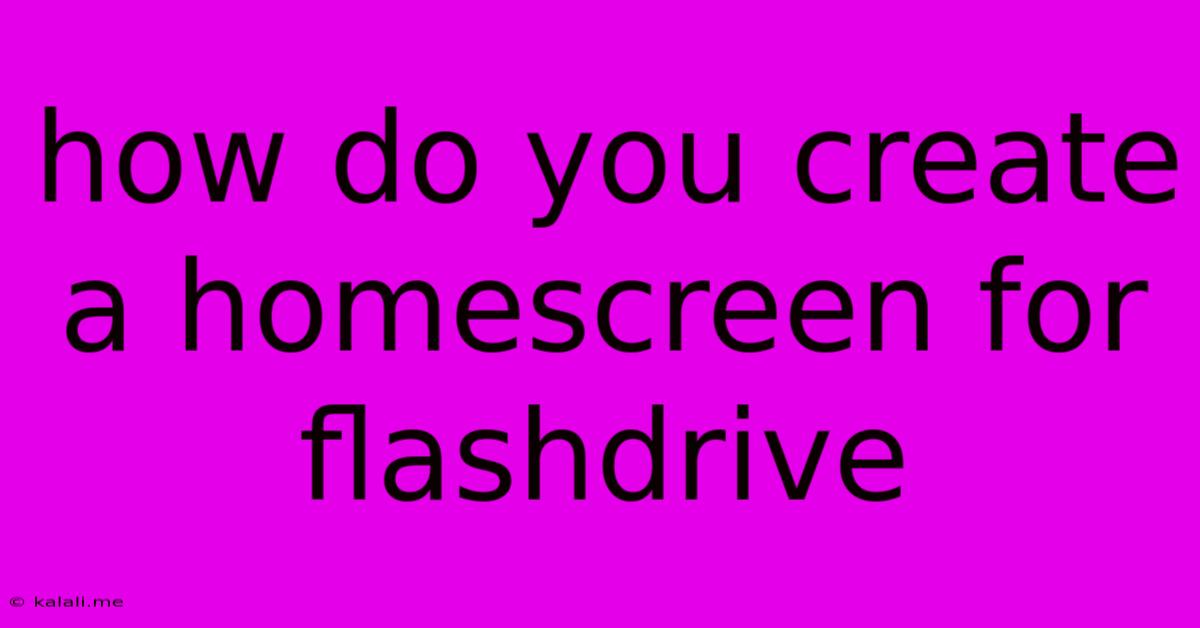How Do You Create A Homescreen For Flashdrive
Kalali
Jun 03, 2025 · 3 min read

Table of Contents
How to Create a Homescreen for Your Flash Drive: A Simple Guide
Want to make your flash drive look less like a generic storage device and more like a personalized, easy-to-navigate system? This guide will walk you through creating a visually appealing and functional homescreen for your flash drive, enhancing its usability and overall appeal. While you can't technically create a "homescreen" in the same way you would on a computer or phone, you can organize its contents to mimic that experience.
Understanding the Limitations: Unlike operating systems on computers or smartphones, flash drives don't have built-in homescreens. They simply act as storage. Therefore, creating a "homescreen" involves structuring the files and folders on the drive for easy access and visual clarity.
Step 1: Choose Your Files and Folders
Before you start organizing, decide what you want readily available on your flash drive's "homescreen." This might include:
- Frequently Accessed Files: Your most important documents, presentations, or media files.
- Program Shortcuts (if applicable): If your flash drive is used to run portable applications, create a folder for shortcuts.
- Folders for Categories: Organize files into logical categories like "Documents," "Pictures," "Videos," etc. This makes finding specific files much easier.
Step 2: Create a Visual Hierarchy
Think of your flash drive's root directory as your homescreen. To create a user-friendly experience, arrange your folders and files logically. A clear visual hierarchy makes navigation intuitive. Consider these best practices:
- Folder Naming: Use clear, concise, and descriptive folder names (e.g., "Important Documents," "Project X," not "Docs," "P").
- Folder Placement: Place frequently used folders at the beginning of the folder list.
- File Organization: Consider using subfolders within main categories to further organize your files.
Step 3: Using Visual Cues (Optional)
Although a flash drive lacks a graphical interface, you can still enhance the visual appeal by using visual cues:
- Color-Coding Folders: While not directly visible on the drive itself, using a consistent color-coding system for folder names (e.g., using a specific color for project-related folders) can help you mentally organize and quickly identify them.
- Descriptive File Names: Use clear and descriptive file names to instantly understand the file's content without opening it.
Step 4: AutoRun (Caution!)
Some might consider using an AutoRun file to launch a specific program or display a custom menu upon insertion. However, be extremely cautious with AutoRun. Many modern operating systems disable AutoRun by default due to security risks associated with malicious software. If you choose to use AutoRun, ensure you fully understand the security implications and only use trusted sources.
Step 5: Regular Maintenance
To keep your flash drive's "homescreen" organized and efficient, adopt these practices:
- Regular Cleanup: Delete unnecessary files and folders to free up space and improve performance.
- Periodic Reorganization: As your file collection grows, periodically reorganize folders and files to maintain the visual hierarchy.
By following these steps, you can effectively create a personalized and functional “homescreen” for your flash drive, enhancing its usability and efficiency. Remember, while you cannot create a graphical interface, strategic organization and naming conventions can dramatically improve the user experience. Remember to always back up important data and be mindful of security risks when dealing with autorun features.
Latest Posts
Latest Posts
-
What Is The Best Gfci Breaker
Jun 05, 2025
-
How To Get Rid Of Villagers Acnh
Jun 05, 2025
-
Why Do Olympic Swimmers Wear Two Caps
Jun 05, 2025
-
What Is The Plural Of Series
Jun 05, 2025
-
Why Do We Associate Certain Objects With Authority
Jun 05, 2025
Related Post
Thank you for visiting our website which covers about How Do You Create A Homescreen For Flashdrive . We hope the information provided has been useful to you. Feel free to contact us if you have any questions or need further assistance. See you next time and don't miss to bookmark.